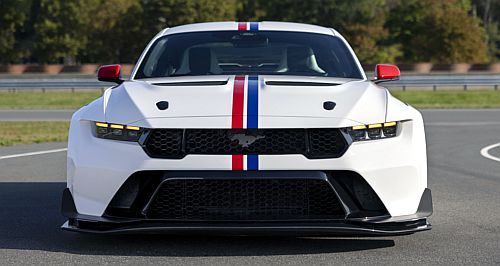Make / Model Search
News - Motor Show - DetroitDetroit Auto Show: Top metal on-showJanuary Detroit Auto Show returns to roots, but Motown vehicle reveals were light-on20 Jan 2025 THE Detroit Auto Show again evolves, ditching the long-standing North American International Auto Show (NAIAS) name for its original moniker as well as returning to its traditional agenda-setting January date on the car industry calendar.
Back in 1899 the event was born when the only automobile dealer in the city, William Metzger, decided to showcase a few vehicles, making it one of only two motoring showcases in the world at the time – alongside the Paris Auto Show.
In 1907, around the time the Detroit Auto Dealers Association (DADA) was formed, the show gained serious traction and has been held annually every year since with the exception of 1941 to 1953, plus the pandemic-affected 2020 and 2021.
Aiming to lend global gravitas to the Detroit event, from 1987 DADA renamed it the North American Auto Show before again expanding the wording to ‘North American International Auto Show’ in 1989.
Following a brief dalliance with other months of the year, for 2025 the show returned to downtown Detroit, using its original name and the January date it was once known for.
But did it live up to the hype? Sort of. Only 16 vehicle manufacturers had official exhibits, so there were only a handful of truly exciting cars on show.
While brands with deep connections to Detroit – Ford, General Motors and Stellantis – took centre stage with by far the largest vehicle displays, the event welcomed an array of other exhibitors like Hagerty, Honda, Volkswagen and bizarrely, the Polish Investment and Trade Agency.
Here is GoAuto’s selection of the top metal on show in Motor City, in no particular order.
Curvaceous CaddyGM luxury brand Cadillac rolled out two particularly exciting vehicles at this year’s Detroit Auto Show – but they could not be more different.
At one end of the spectrum was the brand’s incredibly futuristic Opulent Velocity concept, first unveiled in August last year but making an in-the-metal debut at the show.
Similarly seen in public for the first time but at the more practical – and production-ready – end of the spectrum is the brand’s new Vistiq electric seven-seat SUV, which slots in between the Lyriq that is about to go on sale in Australia and gargantuan Escalade IQ.
Named after its key selling points – Opulence and Velocity – the show car is merely an expression of what Cadillac believes the future could look like, with no confirmed production plans.
According to the official announcement, the Opulent Velocity is a completely self-driving model until the occupant in the driver’s seat decides to engage ‘Velocity mode’ using a multi-function controller within the cabin.
Once Velocity mode is engaged, a steering wheel and pedals present themselves, Cadillac claims, encouraging a driver to engage in the analogue experience of piloting a vehicle.
Aesthetically, the Opulent Velocity shares similarities with Cadillac’s V-Series.R hybrid race cars, resulting in a 2+2 platform that is sleek, low and wildly menacing. We’re not quite sure about the point of a self-driving supercar, though.
The Vistiq, which will become available in the US by mid-year, offers serious range, practicality and luxury but at $78,790 (A$121,404) it won’t come cheap if it makes its way Down Under (which has been speculated, but not confirmed).
While clearly aimed at the luxury end of the market, competing with models like the Mercedes-Benz EQS, the Vistiq does offer prodigious outputs of 460kW/880Nm and a 0-100km/h sprint time of just 3.7 seconds – putting it deep within supercar territory.
Halcyon descendsChrysler, which sits under the Stellantis umbrella of brands, gave the public a look at the revealed its future-facing Halcyon concept it revealed images last February.
The brand says the Halcyon exemplifies its fully-electric future vision, featuring sustainable design, full autonomy and a personalised driving experience (if a self-driving car can claim to offer such an experience).
Under the skin is an 800V lithium-sulphur battery, apparently offering a 60 per cent lower carbon footprint than today’s battery options, but power and performance figures are yet to be revealed.
Chrysler has confirmed, however, that the concept is built atop its parent company’s STLA Large vehicle platform while claiming a 0-100km/h time of around two seconds and a range of 800km.
The brand also celebrated the not-exactly-riveting achievement of 10 years of its Stow ‘n Go seating and storage system.
Since launching Stow ‘n Go in 2005, around five million minivans have been fitted with the solution.
To celebrate the minivan milestone Chrysler kicked off its Stow ‘n Go Challenge at the Detroit Motor Show, which put participants to the test to see who could pack the most road-trip gear within a set time frame.
On a significantly more exciting note, Chrysler also celebrates a century in 2025 having formed as a corporation all the way back in 1925.
“Chrysler brand will mark its 100th anniversary in 2025, and that Century of Innovation has been driven by decades of leadership in design, technology and capability,” said Chrysler chief executive, Chris Feuell.
“Stow ‘n Go seating is one of a lengthy list of Chrysler brand innovations that has made life easier and better for our customers.”
Can the brand survive another 100 years? With models like the Halcyon, perhaps!
Blue Oval blitzFord was in full force at the Detroit Auto Show, rolling out a range of trim options, high-performance models and one-off racers.
Arguably the most radical vehicle on the Ford stand was its F-150 Lightning SuperTruck, which blitzed the competition at Pikes Peak International Hill Climb last year by setting a time of 8:53.553 – the fastest in a field of 61 racers.
The manic electric race rig also set a new qualifying record for the Pikes Peak open class with a time of 3:32.831, which is more than seven seconds faster than the previous benchmark set by the Ford Performance SuperVan 4.2 in 2023.
With a gargantuan power output of 1190kW, and producing up to 2720kg of downforce at 240km/h, the Lighting SuperTruck has to be one of Ford’s wildest creations and is proof that electric vehicles can, indeed, be cool.
Coming back down to earth, Ford also showed its GTD Spirit of America Edition Mustang, which pays homage to the ’Stang that beat Europe’s best at Nurburgring back in 1962 when it set a sub-seven-second lap time.
The GTD Spirit of America features racing stripes, exposed carbon and a bulging body kit, but beneath the metal is a 600kW/900Nm beating heart capable of propelling the steed to a top speed of 325km/h – making this the fastest road-going Mustang ever.
Ford also had the all-new Mustang RTR on display, which is a special edition EcoBoost model that was developed alongside professional drifter and RTR Vehicles president and founder, Vaughn Gittin Jr. – proving the four-cylinder turbo models have serious performance potential.
Oddly, despite teasing big brakes, an electronic drift brake and other ready-to-rock performance goodies, Ford did not quote power levels for the new model.
This was, however, a teaser for the production model so we expect meaty power figures will be shared in due course.
On top of Ford’s dominant vehicle display at the show, the brand’s Australian-engineered Ranger also beat the Toyota Tacoma and Ram 1500 to take out the midsize pickup category of the North American Car, Truck and Utility Vehicle of the Year awards.
Bourgeois BuickQuirky General Motors premium brand Buick first revealed its Wildcat EV concept in 2022 but the model was again rolled out at the Detroit Motor Show this year.
Buick does have a history of oddball concepts, with an array of bizarre Wildcat designs rolled out across the ages, as well as plenty of performance icons that made their way into production, like the GNX – which boasted a sub-five-second 0-100km/h time all the way back in 1987.
However, in recent years the somewhat sleepy brand has undergone an identity shift, complete with a new design language premiered in the radical Wildcat EV concept, and it also plans to be all-electric by 2030.
Little is known about the underpinnings of the not-so-new Wildcat EV concept, despite Buick rolling it for the show – nor is there any indication of whether it will ever see the light of day in production form.
In any case, Buick’s first electric models are set to hit the roads in 2025 starting with the Electra E5, so we can only hope the Wildcat EV concept, in some form or another, makes its way into the brand’s product line-up in the future.
Hagerty in HollywoodSpecialist insurer and automotive lifestyle company Hagerty invited punters for a stroll down memory lane, wheeling out countless Hollywood icons from car-chase cult cars to quirky one-off oddities.
Among the wacky wheels was the Jeep Wrangler that sped from dinosaurs in Jurassic Park, the Ford Crown Victoria from National Lampoon’s Vacation, and arguably our favourite – the Volkswagen Beetle ‘Shagmobile’ from Austin Powers 2: The Spy Who Shagged Me.
For those who prefer their vehicles with a splash of bravado, Magnum P.I.’s Ferrari 308 GTSi was on display, minus Tom Selleck’s extraordinary ’tache, and the Pontiac Trans-Am K.I.T.T. from Knight Rider also made an appearance.  Read more16th of January 2024  VinFast CES success spurs Aussie design houseGomotiv flying Aussie flag on world stage for full vehicle concept and production work |
Click to shareMotor Show articlesResearch Motor Show Motor industry news |











Facebook Twitter Instagram